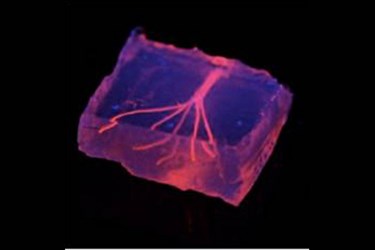Researchers 3D Print Blood Vessels
By Joel Lindsey

Researchers at Brigham and Women’s Hospital (BWH) in Boston have found a way to effectively make 3D printed blood vessels, a development they say could pave the way toward manufacturing viable, individually tailored, transplantable tissues.
“Vascularization remains a critical challenge in tissue engineering. The development of vascular networks within densely populated and metabolically functional tissues facilitate transport of nutrients and removal of waste products, thus preserving cellular viability over a long period of time,” the researchers wrote in a paper published recently in the journal Lab on a Chip. “Overall, our proposed strategy represents an effective technique for vascularization of hydrogel constructs with useful applications in tissue engineering and organs on a chip.”
The researcher team began by using a 3D bioprinter to create an agarose fiber template. Using this as a basic mold for the rest of the structure, they then covered the agarose fiber with a gelatin-like hydrogel, essentially forming a cast over the mold. Researchers then reinforced the cast with a network of photocrosslinks.
“Our approach involves the printing of agarose fibers that become the blood vessel channels. But what is unique about our approach is that the fiber templates we printed are strong enough that we can physically remove them to make the channels,” Ali Khademhosseini, director of the BWH Biomaterials Innovation Research Center and senior member of the research team, said in a press release. “This prevents having to dissolve these template layers, which may not be so good for the cells that are entrapped in the surrounding gel.”
In early experiments with the 3D printed vessels, the researchers found that they could use their technique to create a variety of architectural features and microchannel networks. They also discovered that the blood vessels could be successfully embedded in a variety of commonly used hydrogels, potentially making them more useable in future applications.
In particular, researchers involved with the project say that their technique for making blood vessels could prove beneficial in one day helping to manufacture highly specialized and implantable human tissue.
“In the future, 3D printing technology may be used to develop transplantable tissues customized to each patient’s need or be used outside the body to develop drugs that are safe and effective,” said Khademhosseini.
Image credit: Khademhosseini Lab
